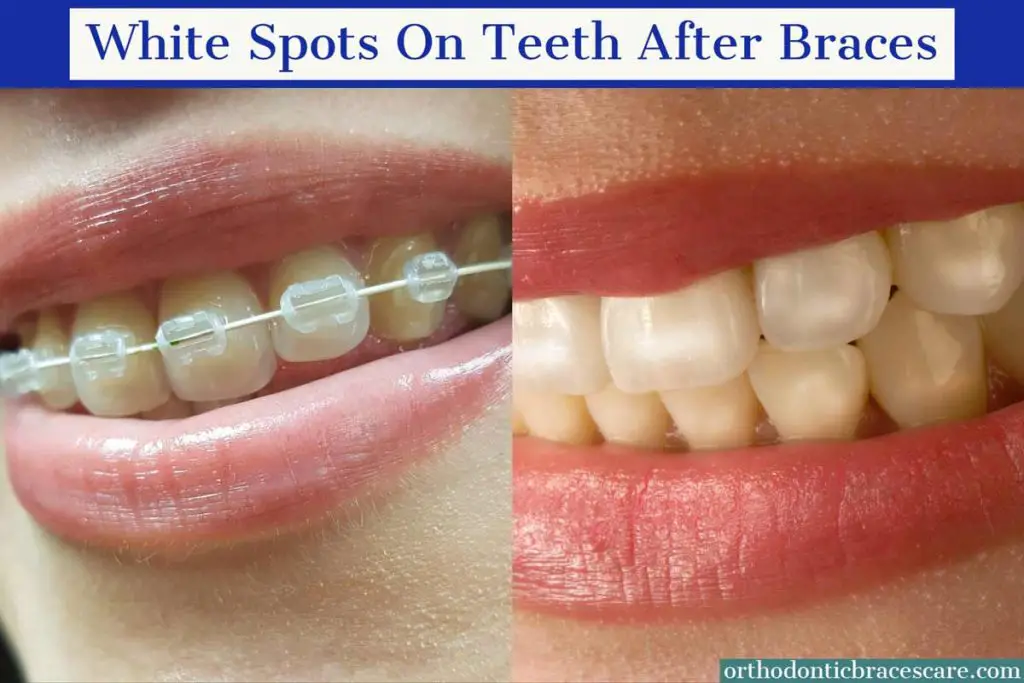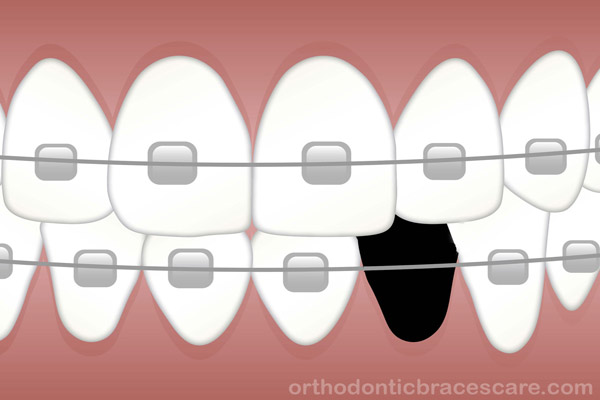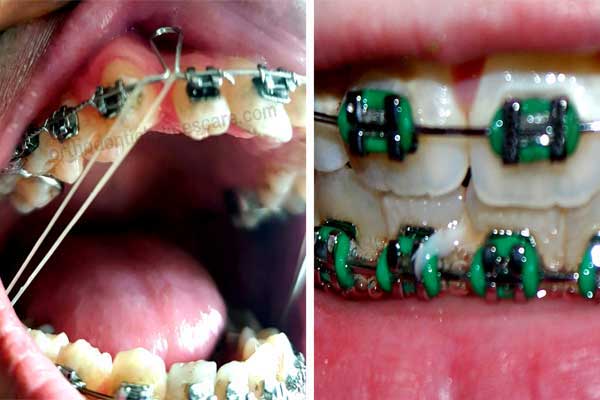Last updated on July 15th, 2022 at 10:33 am
After getting braces off, you may get even teeth and a beautiful smile, but the shade of your teeth may not be the same as they were before. Sometimes, you may notice white spots on your teeth after braces.
But, why do you get white spots and how to fix them after braces off? Here, we have discussed in detail regarding white marks or stains on teeth.
What are the white spots on teeth after braces?
White sports are small discolored areas or remarkably lighter than the surrounding area of the teeth resulting from mineral loss below the outer surface of the enamel.

These small chalky-like areas may feel slightly different than other areas, and sometimes feel softer. These occur in hard-to-reach areas for brushing and flossing.
Demineralization of teeth is the result of plaque and food debris staying on your teeth for a long time.
Bacteria produce acids to damage your enamel. Negligence of oral hygiene while wearing braces triggers the process more than normal.
However, white spot lesion (wsl) may occur even without braces on teeth due to excess intake of fluorosis, genetic, or nutritional factors.
You need to maintain oral hygiene and take a healthy diet to get rid of them.
Also, know about the causes of your teeth looking weird after braces.
How common are white spots after braces?
White spot after braces off is a very common problem as cleaning teeth thoroughly is a hard task with braces on.
People wonder to see those spots, as they don’t expect any. Braces and wires create more irregular surfaces on the teeth.
When food particles get stuck between braces and teeth, they are hard to remove completely.
Those who maintain proper oral hygiene may prevent this problem.
What causes white spots on teeth with braces?
Here are the cause and the process of how you get white spots on teeth after braces:
1. Not cleaning teeth properly and regularly
You must maintain oral hygiene while wearing braces. Even though you try your best you may not clean your teeth and braces from all the plaque or food debris with braces on teeth.
Moreover, when you don’t clean your teeth regularly, it makes the situation worse. Not brushing and flossing teeth properly leads to plaque and cavity formation and you may get a white spot. Learn more effect of not brushing teeth with braces.
2. Plaque buildup
If you can’t prevent building up of excess plaque between teeth and braces, bacteria get favor to destroy your teeth.
3. Excessive acid erosion from bacteria on enamel
Normally your mouth carries a lot of bacteria. All of them aren’t bad. However, when some bacteria get a favorable environment for them, they start to harm your teeth and gums.
When you don’t clean your teeth thoroughly, bacteria and food debris start to build up plaque on your teeth. Bacteria in plaque produce acid to weaken the enamel.
This starts the process of demineralizing your enamel. Gradually, your enamel gets dissolved and dentin gets destroyed due to the acid erosion of bacteria.
If it is left untreated for a long time, you turn into a hole, called a tooth cavity. But, in the beginning, you don’t see the hole in the tooth.
Your tooth shows you the white spot. At first, your tooth gets decalcified from the deeper layer of enamel, not from the outer layer.
At this moment, when you see the enamel, you may find the outer layer is intact, but you can find the white spot due to the calcification.
After sometimes the outer layer of enamel also gets decalcified and you can see the hole at that moment, that’s called the tooth cavity.
4. Sugary and acidic foods
As maintaining oral hygiene is hard for braces wearers, they need to eat foods that don’t get stuck to their teeth and braces.
When sticky and sugary foods adhere to your teeth and stay for a long time, they cause more plaque in your teeth.
Bacteria get deposited in the area and cause acidic destruction of your enamel. Therefore, you develop tooth decay and white spots.
Acid drinks and foods also weaken the enamel and cause white spots.
These can also make you teeth turn yellow.
What happens if you have white spots on your teeth after braces?
Though it’s common to have a white spot on teeth while wearing braces, you can prevent it to make the situation worse by maintaining proper oral hygiene.
In fact, if you clean your teeth properly, you stop it from happening in the first place. People may also get those white spots on teeth even without braces if they don’t maintain oral hygiene.
However, once the spot is formed, it won’t go away on its own. If you don’t prevent it from spreading, it will cause serious problems.
So, you need to prevent it and see your dentist treat the problem.
Here are the effects of white spots on your teeth after braces if you don’t take any precaution:
1. Sensitive teeth
First of all, your teeth feel sensitive. You may develop sensitivity to hot, cold or sugary foods.
2. Tooth decay
It will turn into a big cavity and destroy your dentin as well as whole teeth.
3. Foul smell from mouth
When the spot gets worse, it spread a foul smell.
4. Pain or night pain in affected teeth
This leads to pain and the death of the pulp of your teeth over time, called pulpits.
Do white spots on teeth go away after braces?
Minor white spots on braces may go away on their own if you maintain regular teeth cleaning and these aren’t permanent. But, if you can’t maintain oral hygiene, the situation will get worse.
Meanwhile, if the condition of the tooth isn’t good, you may need to use special tooth remineralizing or fluoride toothpaste or, seek a dentist to remove the white spots applying methods like remineralizing, bleaching or dental veneer.
How to get rid of white spots on teeth after braces?
After getting braces off, you want to be happy to see your beautiful teeth and smile. But, if the teeth have white spots on teeth that look unnatural make you upset.
So, you try to find a way to remove those white stains from the teeth.
Here are the ways how to remove white spots on teeth after braces off:
1. Removing white spots on teeth at home
You can remove the white stains from your teeth after braces at home if the problem is mild.
Regular tooth brushing and flossing
When your white spots are minor, you don’t need to do anything special for that.
You just have to maintain regular tooth cleaning like brushing teeth at least twice a day and flossing at least once a day.
If you do it, mild spots go away on their own. Clean teeth thoroughly after each meal and remove food debris from your teeth.
However, make an appointment with your dentist to know if you need to take some special measurements to remove the white marks from the teeth.
Using remineralizing agents
As your teeth get demineralized, you need to use minerals or fluorides to remineralize or regain the lost minerals.
You can use a cream containing minerals. Consult with your dentist to use at home. This remineralizes your teeth and removes the white spot from your teeth.
Using fluoride toothpaste
You have to repair the enamel to fix the white spot. So, use fluoride and nanohydroxyapatite containing toothpaste with an ADA seal for 3 to 6 months.
They strengthen and remineralize the enamel slowly. As a result, white spots disappear.
Applying tooth whitening products
You can use tooth whitening toothpaste after remineralization is completed and the white spot disappears.
It helps even out the color of your teeth and makes them whiter and bridges.
You can also use a tooth whitening tray with gels to whiten your teeth. It makes your teeth whiter than the whitening toothpaste.
Get it from our dentist or consult with him or her before you get one. Gels are placed in the tray and they are applied to teeth for a few minutes.
It contains bleaching agents that remove internal stain from your teeth and make them whiter.
2. Removing white spots on teeth in the dentist’s office
If the white spots can’t be removed at home, you need to visit the dentist’s office and take the following treatments:
Remineralizing method
To remove the white spots, you need to repair the loss of your enamel. So, remineralizing is a very effective in-office white spots removal technique.
It can effectively restore the affected structure of your enamel and eliminate the white spots. Your dentist uses fluoride and remineralizing agents in the office to achieve this.
Your dentist will prescribe you remineralizing or fluoride gels or paste. This paste releases calcium, phosphorus, and fluoride and causes mineralization.
This restores the loss structure of your enamel.
In-office bleaching
After the elimination of white stains, you can take in-office bleaching or tooth whitening treatment at your dentist’s office.
This aids in even out the color of teeth and makes them look whiter.
Resin treatment
In severe cases, you may need resin treatment to remove the white spots. Your dentist uses resin just like he or she uses resin to fill the cavities.
The resin liquid is injected beneath the surface of enamel in the place of the white spot.
The light is used to harden the resin. As the resin resembles the color of the tooth, it gets the natural appearance.
Microabrasion
Another effective procedure to remove white stains from teeth is called microabrasion. In this method, the tooth is isolated with a rubber dam.
Then, your dentist applies an acid-abrasive gel using a polishing brush with a little pressure to eliminate the spots. It also prevents tooth decay.
Dental veneers
When you have serious white spots on teeth that can’t be restored by other techniques, you may go for cosmetic techniques such as dental veneers.
Veneer, which is simply known as a cap, is placed over the front of your tooth. This is too strong and gives you a more natural look.
How do you prevent white spots on your teeth with braces?
It’s the best idea to prevent white spots from happening in the first place by maintaining the following steps:
1. Clean teeth regularly
Cleaning teeth with braces is more important because braces and wires create a lot of irregular surfaces on teeth where foods and plaques get deposited.
You need to remove all food particles from every area of teeth and braces. Try to remove plaque as much as possible. Your aim is to keep the plaques at a minimum level.
Clean your teeth after each meal. Brush your teeth for 2 minutes at least twice a day. Flossing is necessary with braces.
Floss teeth at least once a day. Rinse your mouth with water every time you eat something.
2. Apply the proper method of tooth cleaning
As cleaning teeth with braces is a difficult task, learn the appropriate techniques of brushing and flossing teeth with braces on teeth.
Besides, if you aren’t careful, braces may get hurt while cleaning teeth. Buy proper toothpaste containing fluoride for braces.
3. Use special toothbrush
Use a soft-bristle toothbrush. You can also use electric or interdental toothbrushes for braces.
They can clean your teeth and braces more thoroughly with these. Electric toothbrushes produce extra vibration.
This loosens the plaque and helps remove them more than a regular toothbrush. You may get an electric toothbrush that’s prepared especially for braces.
4. Use special floss for braces
Buy and use braces-friendly flosses such as a water flosser or floss threader. Waterpik helps remove food debris and plaques more than Waterpik losers.
You can clean the gumline of teeth and in between teeth and braces properly with it. Regular toothbrushes and floss can’t do that well. However, an electric toothbrush is better than a Waterpik.
5. Change your food habits
Don’t take foods frequently with braces on. Saliva neutralizes acid in your mouth and reduces tooth mineralization.
Taking a between-meal snack prevents saliva from doing this. So, give it time to do the work. Even if you eat sometimes, rinse your mouth with water and maintain a tooth cleaning routine.
6. Avoid hard, sticky, acidic and sugary foods
When you take sticky and hard foods, they get stuck between your braces and teeth. Those food particles are difficult to remove.
When food debris stays there for a longer duration, it causes the accumulation of more plaque and bacteria. This leads to white spots.
Those foods also damage your braces. If the foods are sugary or acidic, they do more harm. Normally foods create more acid in your mouth which is neutralized naturally.
But, acidic or frequent intake of foods keeps the acid environment in your mouth for a long time that may dissolve enamel. So, avoid foods that aren’t good for braces. Eat soft and braces-friendly foods.
7. Take regular dental cleaning treatment
You should take regular dental cleaning to your dentist every 6 months. This removes plaque from those surfaces of teeth that you can’t remove with tooth cleaning products.
8. Take in-office fluoride gets, sealants or varnishes
During the orthodontic treatment, you can visit your dentist to get fluoride-containing gels, sealants, or varnishes to prevent the white spots.
The sealant makes a coat over your enamel and protects them from the white stains. On the other hand, the varnish covers the enamel and helps rebuild it.
9. Drink plenty of water
Take at least 2 to 3 little drops of water per day. Drinking plenty of water keeps your mouth moist and reduces the risk of white spots.
Do braces leave marks on your teeth?
Braces don’t leave any marks or cause any white or yellow spot on teeth directly.
You get tooth discoloration or white spots because of poor tooth-cleaning techniques, wrong food habits, and not maintaining oral hygiene while wearing braces.
You can also check our other article to know how to get rid of any braces stain and whiten teeth with braces.
Takeaways
You may get white spots on teeth after braces because of poor tooth cleaning technique, failure
to maintain oral hygiene or wrong food habits.
You can get rid of the mild white stains at home by using various tooth cleaning and whitening products.
In some cases, you may need to remineralize your affected enamel with remineralizing agents or topical fluorides such as gels or paste that can be used at home or in the office.
You can also get resin treatment or dental veneer in the dentist’s office. Maintain regular teeth cleaning routine and eat braces-friendly foods to prevent white spots with braces.

Dr. Pallab Kishore, MS in Orthodontics and owner of Orthodontic Braces Care, shares expert tips on braces, aligners, and oral health from 10+ years of experience.


